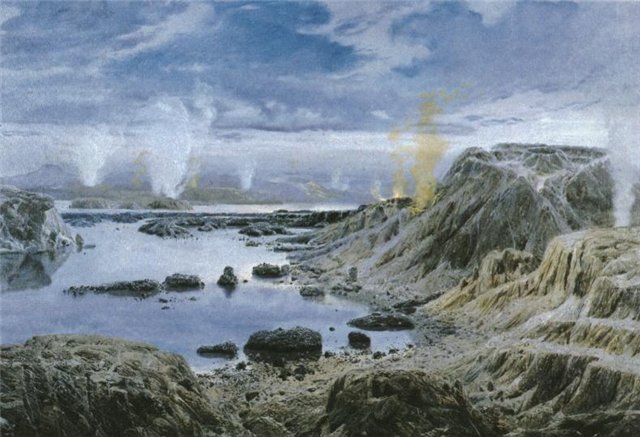|
|
The Hadean Eon |
| Hadean |
The Mesohadean Era |
The Mesohadean Era

The surface of the Earth as it may have appeared during the middle Hadean, when an ocean, atmosphere, and quite possibly life was present. Artwork by Zdenek Burian (originally intended to represent the Archean era, but the volcanic outgassing and steamy atmosphere makes this evocative work much more representative of the middle to late Hadean, although the scene in the early Archean may not have been that different). |

Outcrop of metamorphosed volcano-sedimentary rocks from the Porpoise Cove locality, Nuvvuagittuq supracrustal belt, Canada. Some of these rocks have Samarium-Neodymium dated ages in excess of 4.0 Ga and may be the oldest rocks on Earth. Source: NASA, via Wikipedia (public domain) |
In the Chaotian-Hadean timescale proposed by Goldblatt et al. 2010, the second of the three Hadean eras (the Mesohadean) is divided into an earlier, Canadian period, named after the earliest crustal material, dated at 4.28 Ga (O'Neil et al., 2008), the Nuvvuagittuq greenstone belt, on the eastern shore of Hudson Bay in northern Quebec (right); although this date has been challenged .
Goldblatt et al. 2010 suggest the following period be named Procrustean (4.2 to 4.1 Ga) "from Procrustes, whose bed fitted all life". In any case, we can assume that, from the late Palaeohadean through the Mesohadean, was the period when the first continents began to form. To further explain this process, I have resorted to lifting the remainder of this page from Wikipedia in a rather unoriginal manner. MAK110906
Mantle convection, the process that drives plate tectonics today, is a result of heat flow from the core to the Earth's surface. It involves the creation of rigid tectonic plates at mid-oceanic ridges. These plates are destroyed by subduction into the mantle at subduction zones. The inner Earth was warmer during the Hadean and Archean eons, so convection in the mantle must have been faster. When a process similar to present day plate tectonics did occur, this would have gone faster too. Most geologists believe that during the Hadean and Archaean, subduction zones were more common, and therefore tectonic plates were smaller.
The initial crust, formed when the Earth's surface first solidified, totally disappeared from a combination of this fast Hadean plate tectonics and the intense impacts of the Late Heavy Bombardment. It is, however, assumed that this crust must have been basaltic in composition, like today's oceanic crust, because little crustal differentiation had yet taken place. The first larger pieces of continental crust, which is a product of differentiation of lighter elements during partial melting in the lower crust, appeared at the end of the Hadean, about 4.0 Ga. What is left of these first small continents are called cratons. These pieces of late Hadean and early Archaean crust form the cores around which today's continents grew.
The oldest rocks on Earth are found in the North American craton of Canada. They are tonalites from about 4.0 Ga. They show traces of metamorphism by high temperature, but also sedimentary grains that have been rounded by erosion during transport by water, showing rivers and seas existed then (Lunine 1999).
Cratons consist primarily of two alternating types of terranes. The first are so called greenstone belts, consisting of low grade metamorphosed sedimentary rocks. These "greenstones" are similar to the sediments today found in oceanic trenches, above subduction zones. For this reason, greenstones are sometimes seen as evidence for subduction during the Archaean. The second type is a complex of felsic magmatic rocks. These rocks are mostly tonalite, trondhjemite or granodiorite, types of rock similar in composition to granite (hence such terranes are called TTG-terranes). TTG-complexes are seen as the relicts of the first continental crust, formed by partial melting in basalt. The alternation between greenstone belts and TTG-complexes is interpreted as a tectonic situation in which small proto-continents were separated by a thorough network of subduction zones. (Wikipedia)
Ignoring supernaturalism and ancient astronauts, there are two interpretations about the origin of life. Either originated elsewhere in the universe, arriving on Earth from space ( Panspermia), or it originated on Earth. But even if life did arrive from another planet in the Solar System, say Mars (via meteorites), or via comets, this would not explain how life could also exist elsewhere in the galaxy, assuming as we have speculatively done here that it does. Regardless of whether it occurs in primordial oceans on the surface of suitable planets and moons (e.g. Titan, Europa), or more fantastically in interplanetary debris or even interstellar nebula, life evolves from abiotic matter as emerging complexity. It is quite likely that life may have appeared on Earth even during Hadean times. Either then, as a result of high energy cometary and asteroid bombardment and even repeated formation and destruction of oceans, life may have appeared and then been extinguished a number of times, or, having appeared once, it may well have survived in even these extreme conditions (Abramov & Mojzsis 2009), for example hydrothermal vents or refuges deep within the crust. Geochemical evidence for life (microbial activity) has been reported from the early Archean, almost as old as the oldest rocks, although such findings remain controversial as abiotic processes can produce similar results (van Zuilen et al 2002; Brasier et al 2006), although this is not to refute the possibility of life during this time. The following diagram summarises the evidence for early Precambrian life. MAK110907
page uploaded MAK110908, edited RFVS111204


